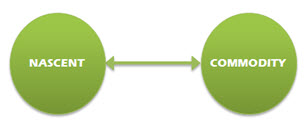One of the first questions I ask any prospective technology client is the following:
“Imagine your product on a spectrum. At one end of that spectrum are commodity products – CRM, for example – people know these products exist, they understand the problem that the products solve, and they recognize when they have that problem.
At the other end are products in a completely nascent category – people have never heard of the product, they don’t know this type of product exists, and they may not even know they have the problem in the first place. Which end of the spectrum are you closer to?”
How a company answers this question tells me a great deal about two things:
1. Whether that company should predominantly use inbound or outbound marketing;
2. The type of content most likely to work best for demand generation.
I’ll explain:
For a company selling a commodity-type product, or close to it, there’s little need to educate the market on why a particular prospect needs that product. People know when they need it; they just need to decide which vendor to do business with. At its essence, marketing commodity products is simply about being in the right place at the right time. As a vendor of CRM solutions (to use that same example), when a prospect determines that he/she has a need for CRM, you want your marketing message to be in a place, at that very moment, that makes your company part of the conversation.
Commodity products are tailor-made for inbound marketing: SEO, paid search (SEM), content marketing, online display advertising. Commodity vendors don’t need to educate prospects about the need for their technology, they just need to establish a critical mass of online presence to the point where a prospect looking for information on that category – on any given day, at any given time – finds their product. We often refer to inbound marketing programs as “air cover” – meaning, they run 24/7 and provide a consistent stream of leads while the company pursues more targeted, tactical campaigns against specific accounts or market segments.
The type of content that works best for commodity products is typically later-stage content: buyer’s guides, case studies, ROI calculators, analyst reports, etc. Again, it’s not essential that the content provide a business case for why a company would want to buy this product, it should simply appeal to a company already shopping for a product in this category.
Technology companies in nascent product categories have an entirely different challenge. Inbound programs can have limited effectiveness because no-one is searching for their type of product. Vendors in these categories need to first educate the market – one, that these products exist, two, that the problem (what prospective clients may perceive as the “status quo”) even exists in the first place, and three, that there’s a compelling business case for investing in the technology.
Companies in these categories need to invest much more, proportionately, in outbound campaigns – that is, taking their message to the audience, rather than simply waiting around for the audience to find them. A company in a nascent product category is more likely to find value in a database marketing approach, one in which they acquire “cold” names of prospects that meet target demographic criteria, and then market to those prospects consistently over time with a stream of informational offers.
Similarly, the type of offer content most likely to work for nascent products is more often early stage content – white papers, infographics, Webinars – offers that have an educational bent and focus on a particular pain, business challenge, or technical issue (coincidentally the very same pain/challenge/issue that the product solves.) Marketers in nascent categories need to educate the market before they can expect people to evaluate their technology.
Inbound marketing can work for nascent products also, but only to the extent that the content on offer speaks to a pain/challenge/issue, market event, or industry trend that prospects are likely to be researching or looking for information on how to address. Social media can play a key role in that it helps spread the word about a particular solution or problem.
Where does your product fit on the spectrum? And does your demand generation strategy align with the type of product you’re selling?
